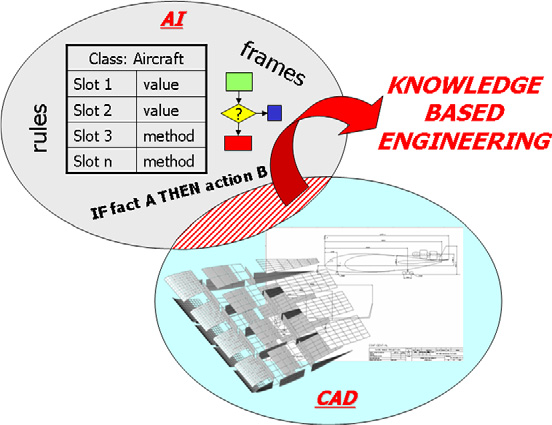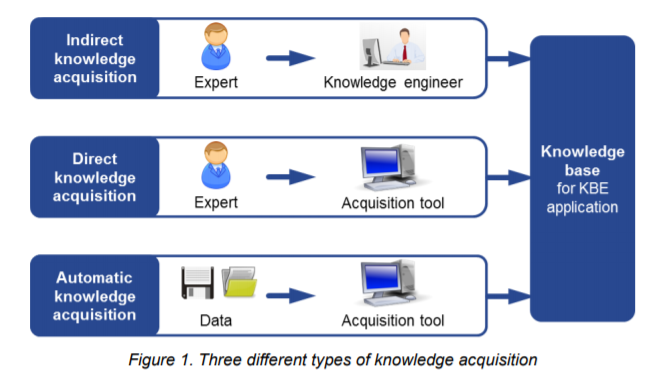Knowledge Based Engineering. Knowledge Acquisition. The Knowledge Acquisition Tool.
That’s a lot of terms that have the word “knowledge” thrown around, that would be my first thought as well. In this article I will try to frame what these things mean for our engineering and manufacturing communities.
From Information Age to Knowledge Age
As we come to grips with the realities of the Information Age, we should realize that pioneers among ourselves are already on the verge of the next revolution. The article, Beyond the Information Age, by Julian Birkinshaw, contains a lot of thought-provoking information on the subject, but the most interesting bit was the following quote.
“The most successful companies in the future will be smart about scanning for information and accessing the knowledge of their employees, but they will favour action over analysis, and they will harness the intuition and gut-feeling of their employees in combination with rational analysis.”
The bolded phrases above, “accessing knowledge,” or “harness the intuition and gut feeling,” are some very powerful words and thoughts. But in all honesty, is this that far-fetched? We live in a world where AI systems like Watson are being deployed to harness the power of medical data to actively generate patient insights for physicians to consider. Furthermore, as these decisions are actively fed back into the system, we are teaching this system “how to think” like a physician, hopefully ones with good bedside manners.
Welcome to the Knowledge Age.
In this knowledge economy, companies have to learn to harness their intellectual capital to retain competitiveness in the marketplace. Knowledge Based Engineering is a collection of key tools and technologies, that is beginning to allow organizations to capture, digitize and deploy on demand the knowledge and experience of their Subject Matter Experts (SME). By capturing into an adaptive knowledge base the human expertise, product and process knowledge; organization requirements; or any other humanly-created entity; it is easier to advance, evolve and engineer new and existing products.

So where do we start? Well, we start by acquiring this knowledge, aptly known as Knowledge Capture or Knowledge Acquisition. From a paper presented at ICED17, the authors identify 3 different ways this acquisition is currently being handled.

Indirect Knowledge Acquisition
As human knowledge and gained experiences are often difficult to retrieve and formulate, the knowledge engineer has to extract the expert’s knowledge. Subsequently, the knowledge has to be represented in a computer-processable form. It is essential for this type of knowledge acquisition that the knowledge engineer is familiar with the expert’s knowledge domain as he has to internalize the expert’s thought.
A vast majority of us have explored or been down this avenue. Configurator development teams working in non-CAD native environments is a good example of this method. Such scenarios typically lead to long development times and expensive revisions as the product line evolves. In some cases, this means even delaying product launches as the sales teams of today become more and more reliant on “guided selling” tools to put their products in front of the customer.
Direct Knowledge Acquisition
Within this method, the expert directly communicates with an “intelligent” acquisition tool of the system. Communication problems between the knowledge engineer and the expert can be eliminated, as the expert defines his expertise autonomously, fills the knowledge base and evaluates the system’s behavior. The acquisition tool then transfers the expert’s knowledge into an appropriate knowledge representation.
This is the sphere where a CAD-augmented KBE system like Driveworks fits into the picture. With seamless integration into Solidworks and Excel-like syntax for rule writing, your SME will typically find themselves at home in this environment. Their focus is shifted away from how to communicate with systems unfamiliar in their realm, to capturing the logic that drives their product or product design.
Automatic Knowledge Acquisition
The automatic knowledge acquisition transfers text-based knowledge into knowledge that can be processed by a computer and extracts knowledge from case examples, respectively, without the expert’s or knowledge engineer’s intervention. The terms “Knowledge Discovery in Databases” (KDD) or “Data Mining” summarizes the methods of automatic knowledge acquisition, which can be used for different application fields.
Although actively pursued in the consumer sector, applications in the engineering sector is very limited. This is the field where data scientists, algorithms, and inference engines rule. As distant in the future as this may sound, organizations still need to consider the implications of such technologies today.
Take Part in the Knowledge Revolution
So, are you prepared for the Knowledge Revolution? Start proactively thinking about who the SMEs are in your organization, how to harness their knowledge, and how to retain that knowledge in a systemic and useful fashion.
Have Questions?
Want to learn more? Contact us.
Phone: 800-454-2233
Submit Inquiries Online
Share
Meet the Author

